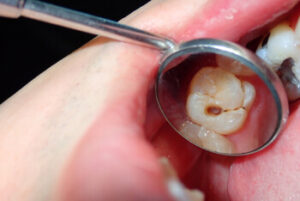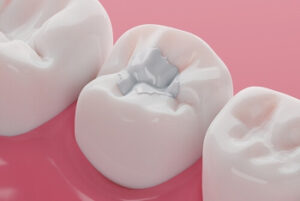Tooth fillings are one of the most common dental procedures. They help restore teeth affected by decay and prevent further damage. If you’re wondering, “How long does a tooth filling take?” The answer can vary based on several factors, including the type of filling material used, the complexity of the decay removal, and the number of fillings required.
In this guide, we’ll explain the tooth filling process, explore different types of dental fillings, and discuss what to expect before, during, and after the procedure. Whether you’re getting composite fillings, amalgam fillings, or ceramic fillings, understanding the process can help you feel more at ease before heading to your dental office.
How Long Does a Filling Take? Breaking It Down
A simple tooth-filling procedure typically takes about an hour. However, several factors can affect the time, including:
- The extent of decay – A small tooth cavity requires less preparation than a large, decayed tooth.
- The number of fillings – If you need multiple fillings, your appointment may be longer.
- The filling material used – Some materials, like composite resin fillings, require extra curing time with a special light.
- The location of the affected tooth: Due to their size and shape, Front teeth are often quicker to fill than molars.
- The complexity of the filling – Indirect fillings, gold fillings, or ceramic fillings take longer as they require custom fabrication.
- The need for additional treatments – If there’s severe decay close to the tooth’s pulp, your dentist may need to perform additional steps, such as placing a liner to protect the tooth or even recommending a root canal treatment.
- Your comfort level—Some patients may require more time for the local anaesthetic to take effect or need breaks during the procedure.
For complex fillings or those requiring indirect fillings like gold fillings or porcelain fillings, the procedure can take longer and may even require more than one visit.
What Happens During a Dental Filling Procedure?
The dental filling procedure is a straightforward process that typically takes about an hour. Here’s what you can expect step by step:
1. Initial Examination and Local Anaesthetic
Before beginning the filling procedure, your dental professional will:
- Examine the affected tooth to assess the severity of dental decay.
- Take X-rays if necessary to determine how deep the tooth cavity extends.
- Apply a local anaesthetic to numb the area around the damaged tooth, ensuring a comfortable experience.
A local anaesthetic may not be required for small cavities, but deeper decay or complex fillings usually need numbing.
2. Decay Removal and Tooth Preparation
Once the area is numb, the dentist will remove the decayed tooth portion using:
- A dental drill
- A laser
- An air abrasion tool
This step eliminates dental caries and prevents further decay. The tooth structure is then shaped and prepared for the filling material.
3. Selecting and Placing the Filling Material
It is important to determine the right type of filling material based on the location of the affected tooth, durability needs, and aesthetic preferences. The dentist will carefully place the chosen material, ensuring a proper fit and secure bond to rebuild the tooth structure and safeguard against additional decay.
4. Shaping and Polishing
Once the filling process is complete, the dentist:
- Shape the tooth-coloured filling to match your natural teeth.
- Polishes the tooth surface to smooth out rough edges.
- Ensures your bite feels comfortable by adjusting the height of the filling.
5. Final Check and Aftercare Advice
After the dental filling procedure, the dentist will:
- Check your bite alignment and make final adjustments.
- Provide oral health tips to maintain the filling.
- Discuss possible tooth sensitivity and how to manage it.
In some cases, if the decay is deep, your dentist might recommend regular dental checkups to monitor the tooth’s health. If discomfort persists, a root canal treatment may be needed.
By following good dental hygiene and avoiding sticky foods or hard foods for the first 24 hours, your dental fillings can last for many years.
Types of Fillings: Which One Is Right for You?
Choosing the right filling material depends on several factors, including durability, appearance, cost, and the location of the affected tooth. Here’s a breakdown of the most common types of dental fillings and their pros and cons.
1. Composite Resin Fillings (Tooth-Coloured Fillings)

- Made from a composite resin material that mimics the shade of your natural teeth.
- Requires special light to harden.
- Strong but may wear down over time, especially in high-pressure areas like molars.
- Suitable for small to medium-sized tooth cavities.
- Less resistant to further decay compared to some other options.
2. Amalgam Fillings (Silver Fillings)
Best for: Molars and areas requiring durability.
- Made from a metal amalgam of silver, tin, copper, and mercury.
- Long-lasting and strong, it is ideal for withstanding heavy chewing forces.
- They are more noticeable than tooth-coloured fillings, making them less appealing for front teeth.
- It can expand and contract with temperature changes, potentially leading to cracks in the tooth structure over time.
3. Gold Fillings
Best for: Patients looking for a long-lasting and durable option.
- Custom-made in a dental lab and bonded to the tooth surface.
- Highly durable, often lasting decades with proper care.
- More expensive than other types of fillings.
- Requires multiple visits to the dental office for placement.
4. Porcelain Fillings (Ceramic Fillings)
Best for: Patients looking for durability and aesthetics.
- Customised in a lab to match the colour of natural teeth.
- More stain-resistant than composite resin fillings.
- Stronger than composite material but may be brittle under extreme pressure.
- More expensive than silver fillings and composite resin material.
5. Glass Ionomer Fillings
Best for: Non-load-bearing areas and children’s teeth.
- Releases fluoride, helping to protect against further decay.
- They are less durable than composite resin fillings, making them unsuitable for molars.
- More commonly used for temporary fillings or decay removal in baby teeth.
How to Choose the Right Filling Material
The best filling material for you depends on the following:
- Location of the filling—Tooth-coloured fillings work well for front teeth, while metal or gold fillings are better for molars.
- Durability needed—If you grind your teeth or need a long-lasting solution, gold or ceramic fillings may be better.
- Cost considerations – Amalgam fillings and composite resin fillings are more affordable than gold or porcelain fillings.
- Sensitivity concerns – Some patients prefer composite material or glass ionomer fillings to avoid metal-based options.
Your dental professional will assess your tooth structure and recommend the most suitable dental filling based on your needs.
Tooth Sensitivity and Recovery Time: What to Expect After a Tooth-Filling
You may experience sensitive teeth after the tooth-filling process, particularly when consuming hot, cold, or sugary foods. This sensitivity occurs as the tooth enamel adjusts to the new filling material, and the nerve endings settle after the dental procedure. In most cases, the discomfort is mild and subsides within a few days. Using sensitive toothpaste, avoiding extreme temperatures, and practising good oral hygiene can help ease any temporary discomfort. However, if the sensitivity persists beyond a week or worsens over time, it’s best to consult your dental professional to rule out any underlying issues.
Good Oral Hygiene and Care for Fillings
- Avoid hard foods immediately after your dental treatment.
- Limit sticky foods that can pull at composite resin material.
- Maintain good dental hygiene with regular dental checkups.
- Brush with fluoride treatments to strengthen tooth enamel.
When to See Your Dentist Again
Schedule a follow-up if you experience persistent tooth pain after a filling procedure. In some cases, deep cavities may require a root canal treatment if the decay reaches the tooth structure’s pulp.
What Happens If You Ignore a Tooth Filling?
Delaying a tooth filling can lead to serious oral health issues, including pain, infection, and even tooth loss. Here’s what can happen if you don’t treat a cavity in time:
1. Worsening Tooth Decay
A decayed tooth continues to deteriorate without treatment, weakening the tooth structure and increasing the risk of cracks or breakage.
2. Persistent Pain and Sensitivity
Untreated cavities can cause tooth pain and sensitive teeth, making it uncomfortable to eat or drink, especially hot, cold, or sugary foods.
3. Risk of Infection and Root Canal Treatment
Decay can spread to the tooth’s pulp, leading to infection, swelling, and the need for a root canal treatment or even tooth extraction.
4. Tooth Loss and Expensive Dental Treatments
Severe decay may require removing the affected tooth, leading to costly procedures like dental implants, bridges, or dentures.
5. Bad Breath and Poor Oral Health
Bacteria thrive in untreated dental decay, causing bad breath, gum disease, and further complications.
FAQs About Tooth Fillings
- How long does a tooth filling take?
A simple tooth-filling procedure typically takes about an hour. However, the time may vary depending on factors such as the extent of tooth decay, the filling material used, and whether multiple fillings are required.
- Does getting a tooth filling hurt?
No, the procedure is comfortable because your dental professional will utilise a local anaesthetic to numb the area. You may feel mild pressure or mild discomfort. Some tooth sensitivity may occur after the procedure, but it usually subsides within a few days.
- What is the best type of dental filling?
The best dental fillings depend on factors like durability, aesthetics, and cost. Composite resin fillings blend well with natural teeth, while amalgam fillings are stronger and better suited for molars. Gold fillings and ceramic fillings offer long-term durability but are more expensive.
- How long do tooth fillings last?
- Composite resin fillings: 5–10 years
- Amalgam fillings: 10–15 years
- Gold fillings: 15–30 years
- Porcelain fillings: 10–15 years
- Glass ionomer fillings: 5 years or less
Longevity depends on good oral hygiene, avoiding hard foods, and maintaining regular dental visits.
- Can I eat after a tooth filling?
Yes, but it’s best to wait until the local anaesthetic wears off to avoid biting your cheek or tongue. Sticky foods and hard foods should be avoided for the first 24 hours, especially if you have metal fillings or composite resin material that needs time to fully harden.
- What should I do if my filling falls out?
If your dental filling falls out, contact your dental office as soon as possible. A missing filling can expose your tooth structure to further decay or infection. Avoid chewing on the affected side until it is repaired.
- How do I take care of my fillings?
- Brush twice daily with fluoride treatments.
- Floss regularly to prevent dental decay.
- Avoid excessive sugary foods to prevent dental caries.
- See your dentist regularly for checkups to detect any issues early.
- Can a tooth with a filling still get cavities?
Yes, a tooth cavity can still develop around or under a tooth filling if good dental hygiene is not maintained. Regular checkups help identify early signs of dental decay before they worsen.
- How soon can I brush my teeth after a filling?
You can brush your natural teeth and fillings as usual, but be gentle around the affected tooth if you experience sensitive teeth. Use a soft-bristled toothbrush to avoid irritation.
- When should I replace my dental fillings?
Dental fillings should be replaced if they become loose, cracked, or worn down. Signs you may need a replacement include tooth pain, tooth sensitivity, or visible damage to the tooth surface.
Final Thoughts: How Long Does It Take?

If you suspect a tooth cavity, don’t wait for untreated cavities to worsen. Early treatment with a dental filling procedure can prevent the need for more invasive dental treatments like root canal therapy.
For professional advice tailored to your needs, consult your dental professional and schedule an appointment with Dental 266 at 02 9051 0600. Remember, taking care of cavities early ensures strong, healthy, permanent teeth for years to come!
Note: Any surgical or invasive procedure carries risks. Before proceeding, you should seek a second opinion from an appropriately qualified health practitioner.
References
- U.S. Food and Drug Administration. (n.d.). Dental amalgam fillings. Retrieved from https://www.fda.gov/medical-devices/dental-devices/dental-amalgam-fillings
- News-Medical. (n.d.). The advantages of using glass ionomers in dentistry. Retrieved from https://www.news-medical.net/whitepaper/20180710/The-Advantages-of-Using-Glass-Ionomers-in-Dentistry.aspx
- FDI World Dental Federation. (n.d.). How to practice good oral hygiene. Retrieved from https://www.fdiworlddental.org/how-practice-good-oral-hygiene
- Cleveland Clinic. (n.d.). Root canal. Retrieved from https://my.clevelandclinic.org/health/treatments/21759-root-canal
- Healthline. (n.d.). Dental anesthesia. Retrieved from https://www.healthline.com/health/dental-and-oral-health/dental-anesthesia







